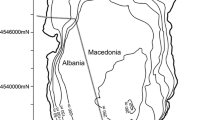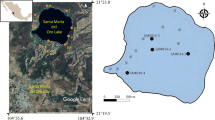Abstract
In order to assess the importance of different pollution sources for the increase in element concentration and accumulation, historical changes in selected elements were studied in the annually laminated sediment of Lake Korttajärvi in Central Finland (62°20′N; 25°41′E). The sediment chronology based on varve counting (256 BC to AD 2005) provided a unique opportunity to explore and date signals of metal emissions, including the ancient metallurgical activities of the Roman Empire at the beginning of the Current Era. Records of this kind are mostly lacking in Finland and northernmost Europe. The stratigraphic sequence of element concentrations did not reflect any major changes in the lake, but changes in element accumulation rates provided distinct pollution signals caused by airborne fallout, catchment erosion, and to some extent municipal wastewater loading. The maximum bulk sedimentation recorded in the twentieth century was 11-fold and organic sedimentation 4-fold higher than the mean background sedimentation rate (256 BC to AD 1019). The increase in the accumulation rates of the majority of the elements, such as Cd, Sn, Pb, Si, Ni, B, Cu, Zn, Sr, Na, K, Sb, Ca, Cr, U and Mg, in descending order, was at least equal to that of bulk sedimentation or much greater, especially for Cd, Sn, and Pb. Changes in the accumulation of Co, Fe, Mn, Mo and As were small and mainly followed those of organic sedimentation. The earliest pollution signals were those of Pb recorded in AD 1055–1141. A weak signal of Pb pollution from the Roman Era was detected in metal concentrations, but this could not be confirmed by the accumulation rate data for Pb.








Similar content being viewed by others

References
Axelsson V, Håkanson L (1971) Sambandet mellan kvicksilverförekomst och sedimentologisk miljö i Ekoln. Del 1 Målsättning och analysmedotik. University Uppsala UNGI Report 11, 35 pp
Brännvall M-L, Bindler R, Emteryd O, Nilsson M, Renberg I (1997) Stable isotope and concentration records of atmospheric lead pollution in peat and lake sediments in Sweden. Water Air Soil Pollut 100:243–252
Brännvall M-L, Bindler R, Renberg I, Emteryd O, Bartnicki J, Billström K (1999) The medieval metal industry was the cradle of modern large-scale atmospheric lead pollution in northern Europe. Environ Sci Technol 33:4391–4395
Brännvall M-L, Bindler R, Emteryd O, Renberg I (2001) Four thousand years of atmospheric lead pollution in northern Europe: a summary from Swedish lake sediments. J Paleolimnol 25:421–435
Burton ED, Phillips IR, Hawker DW (2005) Trace element distribution and enrichment in benthic, estuarine sediments: Southport Broadwater, Australia. Environ Geochem Health 27:369–383
Ek AS, Renberg I (2001) Heavy metal pollution and lake acidity changes caused by one thousand years of copper mining at Falun, central Sweden. J Paleolimnol 26:89–107
Ek AS, Löfgren S, Bergholm J, Qvarfort U (2001) Environmental effects of one thousand years of copper production at Falun, central Sweden. Ambio 30:96–103
Engstrom DR, Wright HE Jr (1984) Chemical stratigraphy of lake sediments as a record of environmental change. In: Haworth EY, Lund JWG (eds) Lake sediments and environmental history. Univ Minnesota Press, Minneapolis, pp 11–67
Gibbs RJ (1993) Metals on the bottom muds in Townsville harbour, Australia. Environ Pollut 81:297–300
Gottfried RS (1983) The Black death. Natural and human disaster in Medieval Europe. Robert Hale, London, p 203
Hakala A, Salonen V-P (2004) The history of airborne lead and other heavy metals as revealed from sediments of Lake Vähä-Pitkusta, SW Finland. Bull Geol Soc Finland 76:19–30
Håkansson L, Jansson M (1983) Principles of lake sedimentology. Springer-Verlag, Berlin, p 316
Hong S, Candelone J-P, Patterson CC, Boutron CF (1994) Greenland ice evidence of hemispheric lead pollution two millennia ago by Greek and Roman civilizations. Science 265:1841–1843
Hyytinen T (1985) Finnish firearms. Arma Fennica ISBN 951-99681-6-4
Itkonen A, Marttila V, Meriläinen JJ, Salonen V-P (1999) 8000-year history of palaeoproductivity in a large boreal lake. J Paleolimnol 21:271–294
Lamoureux SF (1994) Embedding unfrozen lake sediments for thin section preparation. J Paleolimnol 10:141–146
Lee JA, Tallis JH (1973) Regional and historical aspects of lead pollution in Britain. Nature 245:216–218
Matinvesi J (1995) Microbial gas formation altering top sediment composition and its relation to the internal nutrient load in eutrophic lakes. Helsinki Univ of Technology, Otaniemi, p 37
Nef JV (1987) Mining and metallurgy in medieval civilisation. In: Postam MM, Miller E (eds) The Cambridge economic history of Europe II. Trade and history of Middle Ages, 2nd edn. Cambridge University Press, Cambridge, pp 691–760
Norton SA, Kahl JS (1991) Progress in understanding the chemical stratigraphy of metals in lake sediments in relation to acidic precipitation. Hydrobiologia 214:77–84
Ojala AEK, Heinsalu A, Saarnisto M, Tiljander M (2005) Annually laminated sediments date the drainage of the Ancylus Lake and early Holocene shoreline displacement in central Finland. Quat Int 130:63–73
Palomäki A (1996) Water quality and nutrient load in lakes of the Tourujoki watercourse in 1969–1996 (in Finnish). University of Jyväskylä, Institute for Environmental Research, Finland, Report, 18 pp
Pirrie D, Power MR, Rollinson G, Camm GS, Hughes SH, Butcher AR, Hughes P (2003) The spatial distribution and source of arsenic, copper, tin and zinc within the surface sediments of the Fal Estuary, Cornwall, UK. Sedimentology 50:579–595
Renberg I, Wik Persson M, Emteryd O (1994) Preindustrial atmospheric lead contamination detected in Swedish lake sediments. Nature 386:323–326
Renberg I, Bränvall M-L, Bindler R, Emteryd O (2000) Atmospheric lead pollution history during four millennia (2000 BC to 2000 AD) in Sweden. Ambio 29:150–156
Rosman KJR, Chisholm W, Hong S, Candelone J-P, Boutron CF (1997) Lead from Carthaginian and Roman Spanish mines isotopically identified in Greenland ice dated from 600 BC to 300 AD. Environ Sci Technol 31:3413–3416
Saarnisto M (1971a) The upper limit of the Flandrian transgression of Lake Päijänne. Comment Phys-Math 41:149–170
Saarnisto M (1971b) The history of Finnish lakes and Lake Ladoga. Commentationes Physico-Mathematicae 41:373–388
Salonen V-P, Tuovinen N (2001) Orijärvi: a lake impacted by acid mine drainage. In: Lehtonen T, Salminen J-P, Pihlaja K (eds) Proceedings of the fifth Finnish conference of environmental sciences, Turku 2001. Finnish Society for Environmental Sciences, University of Turku, pp 62–64
Settle DM, Patterson CC (1980) Lead in Albacore: guide to lead pollution in Americans. Science 207:1167–1176
Shotyk W, Cheburkin AK, Appleby PG, Fankhauser A, Kramers JD (1996) Two thousand years of atmospheric arsenic, antimony, and lead deposition record in an ombrotrophic peat bog profile, Jura Mountains, Switzerland. Earth Planet Sci Lett 145:E1–E7
Shotyk W, Weiss D, Appleby PG, Cheburkin AK, Frei R, Gloor M, Kramers JD, Reese S, Van der Knaap WO (1998) History of atmospheric lead deposition since 12, 370 yr BP from a bog peat, Jura Mountains, Switzerland. Science 281:1635–1640
Shotyk W, Weiss D, Kramers JD, Frei R, Cheburkin AK, Gloor M, Reese S (2002) New peat bog record of atmospheric lead pollution in Switzerland: Pb concentration, enrichment factors, isotopic composition, and organolead species. Environ Sci Technol 36:2337–2360
Tiljander M (2005) Holocene sedimentary history of annual laminations of Lake Korttajärvi, central Finland. University of Helsinki (ISSN 1795-3499, ISBN 952-10-2158-6), Publications of the Department of Geology D5, 29 pp (https://oa.doria.fi/bitstream/handle/10024/2702/holocene.pdf?sequence=1)
Tiljander M, Ojala A, Saarinen T, Snowball I (2002) Documentation of the physical properties of annually laminated (varved) sediments at a sub-annual to decadel resolution for environmental interpretation. Quat Int 88:5–12
Tiljander M, Saarnisto M, Ojala AEK, Saarinen T (2003) A 3000-year palaeoenvironmental record from annually laminated sediment of Lake Korttajärvi, central Finland. Boreas 32:566–577
Tolonen K, Jaakkola T (1983) History of lake acidification and air pollution studied on sediments in South Finland. Ann Bot Fenn 20:57–78
Verta M, Tolonen K, Simola H (1989) History of heavy metal pollution in Finland as recorded by lake sediments. Sci Total Environ 87(88):1–18
Verta M, Mannio J, Irvonen P, Hirvi J-P, Järvinen O, Piepponen S (1990) Trace metals in Finnish headwater lakes—effects of acidification and airborne load. In: Kauppi P, Anttila P, Kenttämies K (eds) Acidification in Finland. Springer, Berlin, pp 883–908
Virkanen J, Korhola A, Tikkanen M, Blom T (1997) Recent environmental changes in a naturally acidic rocky lake in southern Finland, as reflected in its sediment geochemistry and biostratigraphy. J Paleolimnol 17:191–213
Yang H, Rose N (2005) Trace element pollution records in some UK lake sediments, their history, influence factors and regional differences. Environ Int 31:63–75
Acknowledgments
The Central Finland Regional Environment Centre offered financial support for the geochemical laboratory analyses. We are grateful to two anonymous referees of the journal, who provided valuable comments on the manuscript.
Author information
Authors and Affiliations
Corresponding author
Rights and permissions
About this article
Cite this article
Meriläinen, J.J., Kustula, V., Witick, A. et al. Pollution history from 256 BC to AD 2005 inferred from the accumulation of elements in a varve record of Lake Korttajärvi in Finland. J Paleolimnol 44, 531–545 (2010). https://doi.org/10.1007/s10933-010-9435-3
Received:
Accepted:
Published:
Issue Date:
DOI: https://doi.org/10.1007/s10933-010-9435-3



